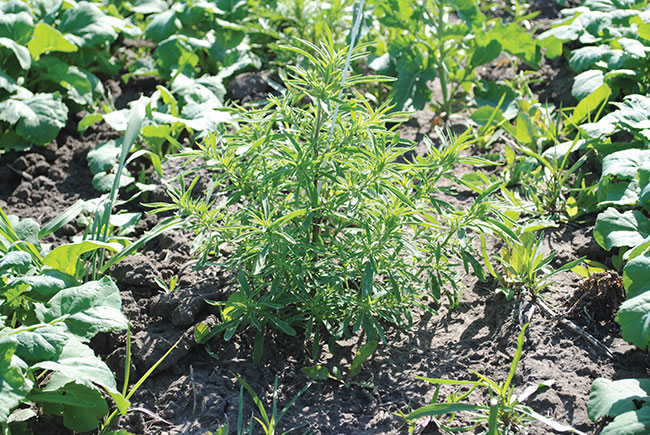
Features
Agronomy Update
Weeds
Harvest Weed Seed Control under evaluation
October 3, 2020 By Bruce Barker, P.Ag, CanadianAgronomist.ca
 Kochia weed growing in field plots. Photo courtesy of H.S.N. Duddu, University of Saskatchewan.
Kochia weed growing in field plots. Photo courtesy of H.S.N. Duddu, University of Saskatchewan.
Recent research by Breanne Tidemann, weed scientist at Agriculture and Agri-Food Canada in Lacombe, Alta., investigated a new Harvest Weed Seed Control (HWSC) tool from Redekop Manufacturing in Saskatoon. The Redekop Seed Control Unit (SCU) is an impact mill that incorporates a blade system in the centre of the mill with the goal to increase suction into the mill and airflow through it.
The objectives of the AAFC research were to evaluate weed seed control with the Redekop SCU, optimize blade configurations between all fan blades and a cutting blade/fan blade combination, and determine if weed seed control levels remain high at higher chaff feeding rates.
Volunteer canola was chosen for its high viability, limited primary dormancy and rapid germination, making it an ideal study species for HWSC. It is also the fourth most abundant weed in annual field crops on the Canadian Prairies. Canola also had similar destruction rates as other weed species when previously tested by other impact mills.
Wheat chaff was collected from a field near Saskatoon with a chaff cart system. Ten thousand seeds of canola were mixed with 3.056 kilograms of wheat chaff, and fed into the cage mill with a conveyor belt. Chaff feeding rate included five and 10 tonnes of chaff per hour.
Average volunteer canola control across treatments was 99.5 per cent. This is similar to control previously observed by the tow-behind Harrington Seed Destructor on volunteer canola, as well as being in the range of control measured on other weeds with the iHSD. It is also the same range of control expected of the Seed Terminator system.
There are currently four integrated impact mills on the market that provide HWSC: the iHSD v.12, the Seed Terminator, the WeedHOG and, the Canadian-made Redekop SCU.
Integrated impact mills were pioneered in Australia, where herbicide-resistant weeds, especially resistant annual ryegrass, have become very difficult to control. The idea is to prevent weed seeds from entering the seedbank at harvest.
In a 2019 national survey, 42 per cent of Australian farmers were using two or more HWSC options. About 42 per cent used narrow row windrow burning to destroy weed seeds, 24 per cent used chaff lining, six per cent used a chaff cart, and six per cent a chaff mill.
More Australian farmers would like to be using the iHSD, but cost is a concern. The original tow behind Harrington Seed Destructor was about $200,000, but integrated units, including the Redekop SCU are retailing around $100,000. Redekop’s price includes their MAV chopper, or $90,000 without the chopper.
Redekop’s SCU is currently available for John Deere S Series combines. For 2021, the SCU can be added on to factory orders of John Deere combines.
In 2001 in Australia, a long-term study of HWSC on annual ryegrass populations in 25 commercial fields was initiated. The fields in the northern region of the Western Australian wheat belt were in continuous cropping rotations. HWSC was used every third year in 12 fields and compared to 13 fields with HWSC once every 10 years for 17 years.
In the first seven years, annual ryegrass populations were reduced from more than five plants per square foot (50/m2) to less than one plant/ft2 for both treatments. After 2008, annual ryegrass populations in the HWSC treatment have consistently been less than 0.1 plant/ft2, while treatment without HWSC have consistently been 0.5 to one plant/ft2.
The key to HWSC is that the weeds must retain their seeds long enough, without shedding, to be captured by the combine. Seed heads must also be high enough on the plant to be harvested.
Previous research by Tidemann found that volunteer canola retained most of its seed by the end of September, cleavers was intermediate and wild oat retained about 20 per cent of the seed by the end of September.
Kochia has good seed retention. A concern is that below the cutter bar height there can still be more than 5,000 kochia seeds. Still, considering that one kochia plant can produce up to 30,000 seeds, that reduction can help.
Tidemann also looked at how effective the Harrington Seed Destructor was at destroying kochia, green foxtail, cleavers, volunteer canola, and wild oat. Overall, it destroyed more than 95 per cent of weed seeds.
Current research by Tidemann is assessing the seed bank of wild oat, cleavers, volunteer canola, hemp nettle, sow thistle and chickweed after three harvests using a Harrington Seed destructor in 20 producer fields. The data is still being sifted through. It will be interesting to see if there is any impact after three years, or whether the reduction will happen over a longer period of time.
Ultimately, the implementation of HWSC will depend on how effective it is at depleting the weed seedbank, and how much economic hurt herbicide resistant weeds will put on Prairie farmers before they have to invest in the technology.

Bruce Barker divides his time between CanadianAgronomist.ca and as Western Field Editor for Top Crop Manager. CanadianAgronomist.ca translates research into agronomic knowledge that agronomists and farmers can use to grow better crops. Read the full Research Insight at CanadianAgronomist.ca